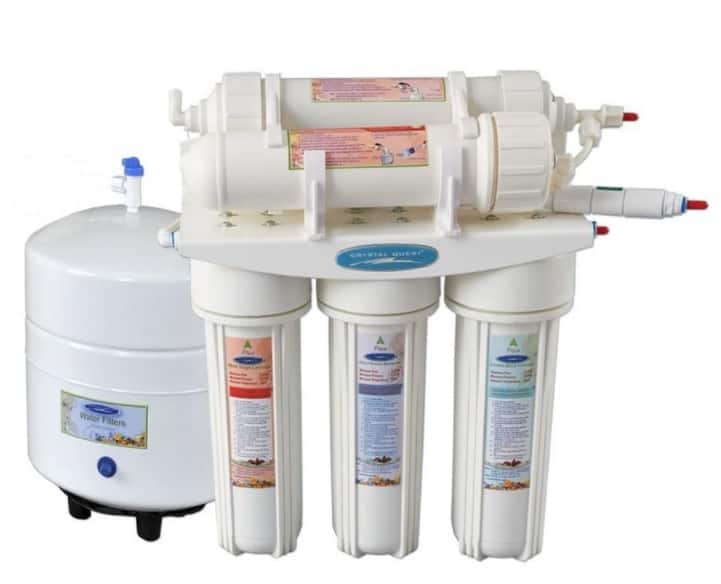Reverse Osmosis filters can remove microplastics, the many stages of reverse osmosis play a different role, so what actually takes out the microplastics, do you need multi-stages?
Finding the perfect water filtration system for your home can be a tough choice.
When looking for a system that can remove microplastics, Reverse Osmosis systems are the way to go whether for the whole house or under the sink.
How Many Stages of Reverse Osmosis to Remove Microplastics? It’s not the number of stages. Microplastics are in the size of 5-20 microns. The presence of mechanical filtration in the Reverse Osmosis system (like sediment removal) removes particles down to 2.5 microns.
Specifically, most Reverse Osmosis water filtration systems can filter particles down to 1-2.5 microns ensuring the removal of microplastics from your drinking water.

The additional stages add value in the other types of contaminants that they remove such as chlorine, chloramine, lead, other heavy metals, and in the return of “good” minerals.
This might sound confusing, so let’s take a closer look.
How Do Reverse Osmosis Systems Remove Microplastics?
As you take a closer look at Reverse Osmosis water filtration systems, it will be no surprise to you why these systems outrank the rest when it comes to high-quality water filtration within your home.
The numerous stages and what each filtration stage entails goes beyond what you could possibly imagine when you first start your research into water filters.
With that said, understanding just how a Reverse Osmosis system removes microplastics can be pretty impressive.
How do Reverse Osmosis Systems Remove Microplastics? Reverse Osmosis water filtration systems have initial sediment and particle removal down to 1-2.5 microns. This filter is effective for microplastics that are typically 5-20 microns.
Or, you can find guaranteed filtration before the final stage of remineralization is complete.
However, the process of remineralization is yet another stage of filtration that ensures the removal of all “bad” particles (like microplastics among other contaminants) before putting the “good” minerals back into the water.
In this way, the Reverse Osmosis water filtration system likely removes microplastics within the first stage of filtration.
Then, the subsequent stages of filtration use technology like ion exchange and granular activated carbon to remove chemical contaminants, heavy metals, etc.
Here, you can note the important difference between mechanical and chemical filtration in a Reverse Osmosis water filtration system.
While mechanical filtration removes physical particles like sediment, microplastics, and other objects. Chemical filtration uses ion exchange, GAC, or other types of technology to remove the chemical contaminants in the water.
In this way, the varying stages of a Reverse Osmosis filter will remove various types of contaminants that you would otherwise find in your drinking water.

Common Stages of Reverse Osmosis
- sediment
- pre-filter
- filter
- membrane
- polishing
- minerals
In each of these different stages, various contaminants are removed from the water (except in the remineralization stage when “good” minerals are added back in).
In these stages, you will find mechanical filtration and chemical filtration in different parts of the water filtration system as a whole.
Then, by the time the water leaves the faucet, it is as high-quality as it can get. Supposedly, the US Navy invented this tech for submarines!
How Do Stages of Reverse Osmosis Filters Affect Microplastic Removal?
With varying stages adding to the many benefits of a Reverse Osmosis water filtration system, it can still be a bit daunting to try to understand what you are really getting out of the multiple stages of filtration.
After all, if microplastics are removed in one of the main stages, what happens in the others?
How do Stages of Reverse Osmosis Filters Affect Microplastic Removal? Since microplastics are removed in the mechanical filtration component of your RO system, the additional stages of filtration are more targeted at the removal of other contaminants which include heavy metals and common pollutants.
With this said, you might be wondering why you should considering investing in a Reverse Osmosis filter that has more stages than others.
But, keep in mind that just because the microplastic removal takes place in the initial and final stage of filtration in a Reverse Osmosis system, this does not mean that the other stages do nothing.
In fact, this is quite the opposite. The sediment removal during the initial stages is intentionally set at the beginning of the water filtration processes.
With physical blockages in the water, it would be more difficult for the other filters to activate the technology that they use to provide high-quality filtration for your water.
For example, if ion exchange were to take place during the initial stage of water filtration in a Reverse Osmosis system, then the heavy metals might not be as well removed as they would be when the other sediments and particles were in the way.
Because of this, these stages flow in a particular order that has been uniquely designed and manufactured by various water filtration companies.
Additionally, you might even find that there are some companies that include more than just the sediment removal in the beginning- and this is just another way that the stages of a Reverse Osmosis filter affects the removal of microplastics.
With Aquasana OptimH20 Reverse Osmosis + Claryum technology, you will find submicron filtration that removes particles even smaller than 1 micron such as fluoride, arsenic, and more.
So, if you are looking for a Reverse Osmosis water filtration that will really do the trick, this is a great option.
How Many Stages of Reverse Osmosis Should I Get?
Now that you recognize that the microplastic removal will take place almost regardless of the number of stages that is incorporated in your Reverse Osmosis water filtration system, you might be considering reducing the number of stages that you pay for.
After all, these water filtration systems are not inexpensive upfront (although they do arguably add value that will pay them off in no time).
How Many Stages of Reverse Osmosis Should I Get? It dependss on your budget, the level of contamination in your water pre-filtration, and personal preferences.
So, if you prefer to stick with a Reverse Osmosis water filtration system that is 3-4 stages, this will still likely remove microplastics and other contaminants. This will generally do the job for most households –
Here is one of my favorites for faucet / undersink from Aquasana (with several design options).
Here is a whole house system from Crystal Quest.
However, if you invest in a higher quality water filtration system like a 6-stage system, then you can see how these additional stages of filtration will continue to add to the overall value and quality of your water (and water filtration system, respectively).

With that in mind, the more stages of filtration you choose to invest in for your Reverse Osmosis water filtration system (whether this is for a whole house water filter system, an under sink water filtration system, or something else), the more membranes and filters your water will pass through before it is brought for your consumption.
What is the Best Type of Water Filtration System for Removing Microplastics?
As you narrow down your search for the water filtration system that you plan to install in your home, it is important to take a closer look at the goals that you hope this water filtration system can accomplish.
After all, it is typically a large investment to choose this device for your home- although anyone who uses water filtration will argue that it is well worth your time, money, and resources.
But, if you are looking specifically to remove microplastics, which direction should you take.
What is the Best Type of Water Filtration System for Removing Microplastics? Reverse Osmosis water filtration systems that can be installed as a whole house water filtration option or under the sink will be very effective. These remove down to 1-2.5 microns in size so they are sure to remove 5-20 micron microplastics.
While other types of water filtration systems are great at removing other contaminants, Reverse Osmosis water filtration systems can remove microplastics in an effective, safe, and convenient way that will allow you to enjoy your cup of water straight from the tap- no microplastics to be seen.
These will be decisions you and your family won’t regret!

